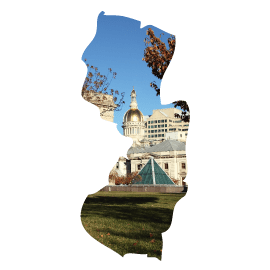Licensure Deficiencies: New Jersey
Special Education Teacher Preparation Policy
Analysis of New Jersey's policies
Although New Jersey offers a K-12 endorsement, it must be added to a general education license that restricts the grade level or subject
matter that can be taught.
However, holders of this special education endorsement may provide "consultative services and supportive resource programs, including supplemental instruction, modification and adaptation of curriculum and instruction to students with disabilities in general education programs in grades preschool through 12."
Recommendations for New Jersey
Consider elementary and secondary specific endorsements for special education teachers.
Providing instruction to children who have special needs requires both
knowledge of effective learning strategies and some knowledge of the
subject matter at hand. Failure to ensure that teachers are well trained
in content areas deprives special education students of the opportunity
to reach their full academic potential.
Further, while New Jersey has taken steps to distinguish between
elementary teachers and secondary levels in terms of content knowledge,
the K-12 endorsement would make it difficult to differentiate in pedagogy preparation. The
broad K-12 umbrella may be appropriate for teachers of low-incidence
special education students, such as those with severe cognitive
disabilities, but it is problematic for the overwhelming majority of
high-incidence special education students, who are expected to learn
grade-level content.
State response to our analysis
New Jersey responded with a helpful question that resulted in our clarification of this goal. The state also noted that recent legislation now requires all programs for instructional certificates to include "6 semester credit hours of classroom instruction, clinical experience, including student internships, or a combination thereof, in special education."
Updated: December 2017
Select another topic
General Teacher Preparation
- Program Entry
- Teacher Shortages and Surpluses
- Program Performance Measures
- Program Reporting Requirements
- Student Teaching/Clinical Practice
- Teaching Methods
Elementary Teacher Preparation
Secondary Teacher Preparation
- Middle School Content Knowledge
- Middle School Licensure Deficiencies
- Adolescent Literacy
- Secondary Content Knowledge
- Secondary Licensure Deficiencies
Special Education Teacher Preparation
Alternate Routes
Hiring
- Requirements for Out-of-State Teachers
- Provisional and Emergency Licensure
- Licensure for Substitute Teachers
- Supporting New Teachers
Teacher and Principal Evaluation
Teacher Compensation
Retaining Effective Teachers
Early Childhood Preparation
How we graded
4C: Special Education Licensure Deficiencies
- Specific Licensure: The state should require its teacher preparation programs to sufficiently distinguish between the differing needs of elementary special education teachers and secondary special education teachers by requiring distinct elementary and secondary special education licenses.
The total goal score is earned based on the following:
- Full credit: The state is only eligible for the full point if it requires teacher preparation programs to sufficiently distinguish between the differing needs of elementary special education teachers and those of secondary special education teachers by requiring distinct elementary and secondary special education licenses. The state is not eligible for any credit if it offers K-12 special education licenses either in isolation or as an alternative to grade-specific licenses.
- One-quarter credit: The state is eligible for one quarter of a point if, in addition to K-12 special education licenses, the state offers both elementary and secondary licenses.
Research rationale
Generic K-12 special education licenses are inappropriate for teachers of high-incidence special education students.
Too many states make no distinction between elementary and secondary special education teachers, certifying all such teachers under a generic K-12 special education license. While this broad umbrella may be appropriate for teachers of low-incidence special education students, such as those with severe cognitive disabilities, it is deeply problematic for high-incidence special education students, who are expected to learn grade-level content.[1] And because the overwhelming majority of special education students are in the high-incidence category, the result is a fundamentally broken system.
It is virtually impossible and certainly impractical for states to ensure that a K-12 teacher knows all the subject matter he or she is expected to teach. Further, the issue is just as valid in terms of pedagogical knowledge. Teacher preparation and licensure for special education teachers must distinguish between elementary and secondary levels, as they do for general education.[2] The current model does little to protect some of our most vulnerable students.
[1] Levenson, N. (2011). Something has got to change: Rethinking special education (Working Paper 2011-01). American Enterprise Institute for Public Policy Research. Retrieved from http://eric.ed.gov/?id=ED521782
[2] Feng, L., & Sass, T. R. (2010). What makes special education teachers special? Teacher training and achievement of students with disabilities (Working Paper 49). National Center for Analysis of Longitudinal Data in Education Research. Retrieved from http://www.urban.org/UploadedPDF/1001435-what-makes-special.pdf; Levenson, N. (2011). Something has got to change: Rethinking special education (Working Paper 2011-01). American Enterprise Institute for Public Policy Research. Retrieved from http://eric.ed.gov/?id=ED521782

